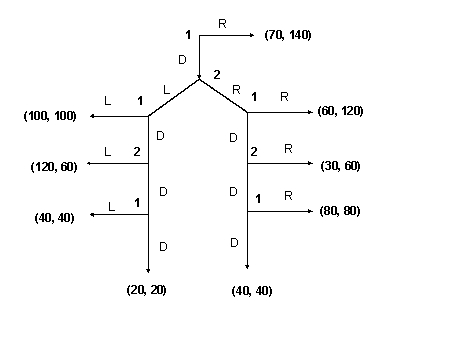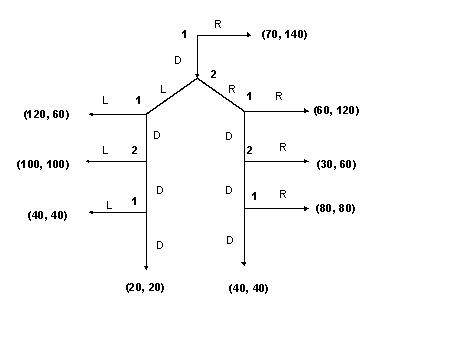Consider the following two two-player games - Game 1 and Game 2. In each game, 1 and 2 refer to the two players. The first number in each payoff box refers to the payoff for player 1 and the second number to the payoff for player 2. The strategies L, R, and D stand for Left, Right and Down respectively. At each node I have shown the player who gets to move at that node.
Game 1:
 Game 2:
Game 2:
 (a) What is the subgame perfect equilibrium in Game 1 and Game 2? (It is the same in both games. So you only need to solve for it once.) (b) In which game - 1 or 2 - is the symmetric joint payoff maximizing outcome of (100, 100) more likely? Is it Game 1 or Game 2? Why? Explain briefly.
(a) What is the subgame perfect equilibrium in Game 1 and Game 2? (It is the same in both games. So you only need to solve for it once.) (b) In which game - 1 or 2 - is the symmetric joint payoff maximizing outcome of (100, 100) more likely? Is it Game 1 or Game 2? Why? Explain briefly.
Correct Answer:
Verified
Q28: The difference between a "trust" contract and
Q29: When Frey and Oberholzer-Gee asked Swiss citizens
Q30: Fehr and Rockenbach conducted a study that
Q31: In the context of the Berg, Dickhaut
Q32: Chaudhuri and Gangadharan (2007) suggest that in
Q33: Denote the amount sent by the Sender
Q34: (a) Describe the Berg, Dickhaut and McCabe
Q35: In talking about the Berg et al.
Q37: (a) Describe the "trust game" introduced by
Q38: The study by Snijders and Keren suggests
Unlock this Answer For Free Now!
View this answer and more for free by performing one of the following actions

Scan the QR code to install the App and get 2 free unlocks

Unlock quizzes for free by uploading documents